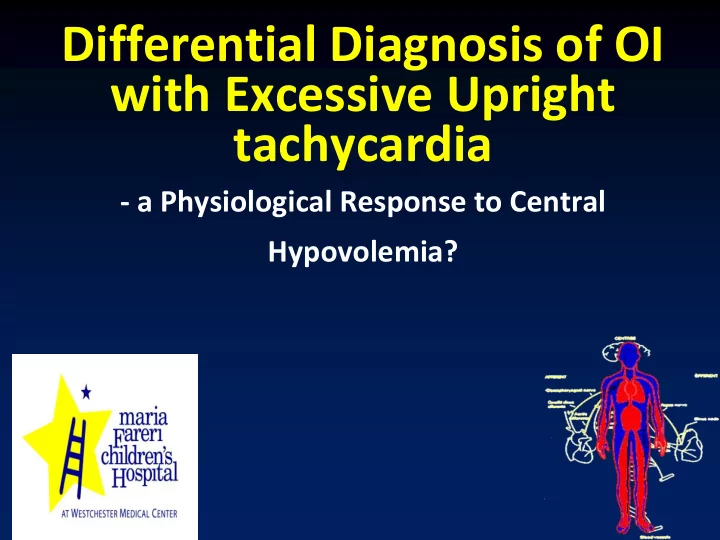

Differential Diagnosis of OI with Excessive Upright tachycardia ‐ a Physiological Response to Central Hypovolemia?
Normal Circulatory Response to Orthostasis
Normal Segmental Changes in Normal Segmental Changes in Impedance and volume with Tilt Impedance and volume with Tilt 16 16 26 120 Impedance (Ohms) Impedance (Ohms) Impedance (Ohms) Impedance (Ohms) 14 24 15 110 12 22 10 14 20 100 0 200 400 600 800 1000 0 200 400 600 800 1000 0 200 400 600 800 1000 0 200 400 600 800 1000 Time (sec) Time (sec) Time (sec) Time (sec) 1.10 1.10 1.10 1.10 Fractional Volume Change Fractional Volume Change Fractional Volume Change Fractional Volume Change 0.97 1.00 1.00 1.00 0.83 0.70 0.90 0.90 0.90 0 200 400 600 800 1000 0 200 400 600 800 1000 0 200 400 600 800 1000 0 200 400 600 800 1000 Time (sec) Time (sec) Time (sec) Time (sec) Thorax Splanchnic Leg Pelvic
POTS is a Disease vs POTS is a Physiological Response Orthostatic Intolerance The presence of one or more symptoms, e. g., lightheadedness, dizziness, nausea, breathlessness, and vision change, linked specifically to assuming or maintaining upright posture, and symptoms abate once supine Etiology is not a criterion. Chronic Orthostatic Intolerance Orthostatic Intolerance for at least 3 months with functional impairment POTS Chronic Orthostatic Intolerance with excessive postural tachycardia (at least 40 bpm change within 10 minutes on standardized passive tilt testing) without significant sustained hypotension in the absence of an alternative explanation. If a specific cause is found (e.g. Addison’s Disease) It is no longer called POTS. But the POTS Response is still present.
Major Variants of Orthostatic Intolerance Comprise a Differential Dx of POTS •Chronic Bedrest •Initial Orthostatic Hypotension •Orthostatic Hypotension •Chronic Orthostatic Intolerance Postural Tachycardia Syndrome (POTS) Chronic OI •Postural Vasovagal Syncope/I.S.T. •Any Condition that Promotes Central Hypovolemia
Gravitational Deconditioning • Reduced blood volume • Cardiovascular remodeling • Different Regional blood volume redistribution • Reduction in the response to norepinephrine/MSNA (and other pressors)
Initial Orthostatic Hypotension Standing g) g) 200 200 ressure ( mmH ressure ( mmH AP AP 100 100 rt eri al P rt eri al P A A 0 0 0 0 20 20 40 40 M A M A P ( mmH P ( mmH g) g) 150 150 at e ( bpm) at e ( bpm) 100 100 HR HR eart R eart R H H 50 50 0 0 20 20 40 40 M A M A P ( mmH P ( mmH g) g)
Orthostatic Hypotension (OH) is Easy to Understand •Blood pressure falls sufficiently to impair brain blood flow •Non-neurogenic OH 120 Arterial Pressure (mmHg) AP 80 • Hypovolemia or Forced Vasodilation 40 0 0 100 200 300 400 HR 150 Heart Rate (bpm) •Neurogenic OH 100 •Autonomic vasoconstrictor failure 50 0 100 200 300 400 Time (sec) due to inadequate release of norepinephrine from sympathetic vasomotor neurons.
Chronic Orthostatic Intolerance: Postural Tachycardia Syndrome (POTS) Day-to-Day Symptoms of OI + + 150 Heart Rate (bpm) HR 120 Excessive Tachycardia 90 60 30 ( without Hypotension) 0 0 100 200 300 400 500 600 Time (sec) Adults Δ >30 or HR>120bpm within 10min Adolescent – Δ >43 120 MAP MAP (mmHg) 100 (IOH a confound)? 80 60 + 40 0 100 200 300 400 500 600 Time (sec) Concurrent Symptoms of OI during testing Schondorf and Low. Idiopathic postural orthostatic tachycardia syndrome: an attenuated form of acute pandysautonomia? Neurology 1995;43:132-137 Improved by Recumbence
What’s This? Tilt down 140 120 Heart Rate (BPM) HR Tilt up 100 80 60 40 0 120 240 360 480 600 IOH BP 150 Blood Pressure (bpm) 100 50 0 0 100 200 300 400 500 600 Time (seconds)
Postural Vasovagal Syncope in the Young Defined by Clinical History 150 HR 1 2 3 120 Heart Rate (bpm) Transient loss of 90 consciousness and postural tone due to 60 global cerebral hypoperfusion and Tilt Up Tilt Down 30 characterized by rapid 0 onset, short duration, and 0 300 600 900 1200 1500 spontaneous recovery. Time (sec) 120 MAP Almost always the result Slow ↓ of systemic hypotension 100 BP MAP (mmHg) 80 Very Common (~40%) 60 Rapid ↓ BP 40 0 300 600 900 1200 1500 Time (sec)
Recommend
More recommend